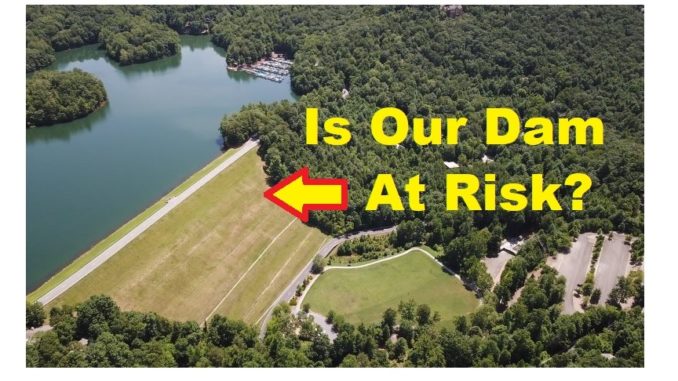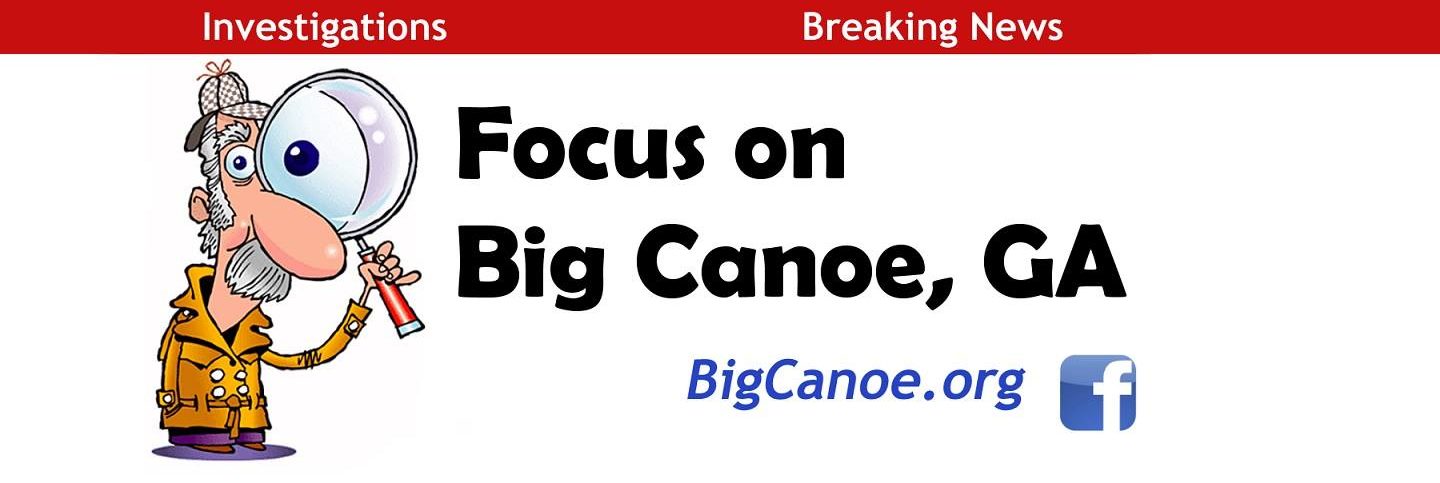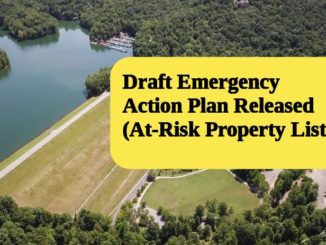
Lake Petit Dam (GA ID# 112-009-00462 / National Inventory Of Dams (NID) ID# GA00685), located in Pickens County Georgia, was completed in 1972. The Permitted & Listed Owner of the Dam is currently shown to be the Big Canoe Corporation, which is the Developer of the private community “Big Canoe” in which the Petit Lake Dam is situated. Lake Petit Dam is one of the largest Earthen Dams in the State of Georgia, listed as being 126 feet tall, 908 feet long, 110 acres, and holds 7500 acres/ft volume of water. Lake Petit Dam is a Class 1 Dam; is listed as a High Hazard Dam; and is legally under an Emergency Action Plan (EAP) requirement.
An Internal Document (1) from 2005 shows that the State required an Emergency Action Plan be developed in 1998, and Big Canoe POA agreed to do this. At the time of document preparation (2005) the writer, then POA Board member (also Board President during 1998) John Baugus wrote,
“…as of this date there is also no evidence that the POA has ever held an exercise on an Emergency Action Plan, if one was ever delivered.”
According to State Law, Rules & Regulations under the Georgia Safe Dams Program, Lake Petit Dam is under the following legal requirements:
- Inspection by “the Dam Owner” on a Quarterly basis, and responsibility to file the resulting Form Specific paperwork with the State. Open Records Requests (State Level and POA Level) have been put in to try and retrieve the documents.
- Inspection by an Engineering Firm from a State Selected List of approved engineers every two years. Geosyntec is Big Canoe’s Engineer of choice, and is on the list. The last report this author could find reference to was in 2017. Records requests have been put in to obtain full copies of those Engineering Reports as well. It is important to note that the Big Canoe POA has never to my knowledge shared the results of those engineering studies openly with property owners.
- “The Dam Owner” is also required to have fully developed Emergency Action Plan (EAP).
Which brings us to present. In the POA Board Workshop Notes for July 2020 (2) the following comment was made:
“The Dam in Big Canoe has been reported having conditions with soft spots/damp sites cited near the spillway. GeoSynTech has been contacted to research the conditions. This work will require decompression devices with the divers working some 99 feet down to uncover the inspection site under layers of sediment.”
This is not the first time that “soft spots/damp sites” have been found. The first time it happened required an estimated $500K reworking of the downside face of the dam, including the layered “steps” you see on the side above the Playfield. They installed horizontal drainways to prevent seepage, which obviously hasn’t fixed the problem.
What could Seepage indicate, and why is it repeatedly being taken so seriously?
The answer to this begins with an understanding of the history of earthen dams, and the mechanisms of their failure. One of the worst dam failures in the nation happened in Toccoa Georgia in 1977, the infamous Kelly Barnes Earthen Dam Failure. In comparison to Lake Petit Dam, it is important to note that the Kelly Barnes Lake Dam was relatively small; only being 38 feet tall, 400 feet long, 40 acres, and volume of 410 acres/ft of water (5% the total water volume of Lake Petit). But the damges were catastrophic, including mass loss of life. Can you imagine what 20X water volume would do?
The mechanism that led to the Kelly Barnes Dam collapse was a combination of spillway erosion, combined with internal seepage, which effectively turned the inside of the dam into an unstable slurry, which during a heavy rain event led to the entire face of the dam just sliding away. There are suggestions that potentially similar conditions are developing within Lake Petit Dam.
Highliting concern is the recent Magnitude 5.1 Eartquake that struck the region. The specific danger that even a moderate seismic event can cause to an earthen dam, especially one that has an unstable or soft core, is very serious, and could trigger a sudden dam failure. The vibrational effect on the soft and wet core structure literally turns it into a slurry, which can result in a “mudslide like” effect in which the heavier top structure of the Dam simply slides off the base.
What would be the immediate results of Lake Petit Dam failing?
4,500 feet downstream the floodwaters of Lake Petit would encounter and overwhelm the Lake Sconti Dam. Just below Sconti the floodwaters would hit one of the community’s primary Water Pump Stations; another 4,000 feet downstream and the Covered Bridge would be taken out, eliminating the main entrance to Big Canoe. 5,000 feet farther downstream the floodwaters would hit the Blackwell Creek Water Station, then meet Cove Road, which would most likely be swept away, breaking a major transportation route to Jasper. Half a mile later the floodwaters would hit Cox Lake (aka Cove Lake) whose dam would most likely also succumb. 2 miles downstream from Cox Lake the combined floodwaters would intersect and quite probably take out Hwy 53. From there the waters would wind down through Ballground, eventually being absorbed into the Etowah River.
The resulting damage to property, infrastructure, and local travel would be catstrophic. Loss of life would be inevitable. The price tag would be unfathomable. I predict that in such a future event, the primary public outcries will be in the form of questions ranked as flows:
- “Who is responsible?”
- “Could this have been avoided?”
- “Who is going to pay for the damages?”
Who Is Responsible?
My prediction is that most answers would point in the general direction of Big Canoe, but from that point things are less legally clear. As is the norm with so many issues between the Big Canoe POA and the Developer, there is no clarity as to the details regarding which entity is legally responsible. Clearly the State and Federal databases list the Big Canoe Developer as “the Owner” of the dam, and as such should be legally responsible for the mandated inspections, maintenance and repairs of the dam – but Big Canoe Property Owners, through the questionable leadership of the various POA Boards, have been seemingly taking the lead in operational matters, scheduling and paying for the intermittent inspections and quick fix repairs, but have been kicking the can on Major Structural Repair for years.
Already $100’s of thousands of dollars have been expended over the years by Big Canoe Property Owners to fund various quick fixes. Internal Reports show that estimates of $2,500,000 were long ago budgeted for future repairs. Those “future repairs” have already been kicked down the road twice in the past few years, originally talked about in the early 2000’s, then scheduled for 2017, then 2019, and now the timeframe isn’t even publicly talked about. Even more disturbing, during 2017, 2018 and 2019 the Capitol Budgets showed $3,550,000 budgeted for Lake Petit Dam Contingency Repairs. But in the 2020 Capital Budget, that Contingency Budget is unexplainedly completely gone…. POOF! It is replaced by a $60,000 figure.
(My guess is that the budgeted monies have been diverted to the “Master Fund” budget to spend on the Creek 9 Golf Course Redesign, which is the current priority and laser focus of the Bob Crouch led POA Board. In fairness, a question to the Board about this was responded to by Amy Tropfenbaum, who haltingly stated that this was not the case – but failed to explain the sudden absence of the $3,550,000 from the Annual 2020 Capital Budget, so I am not sure we have a complete answer to that aspect yet.)
Lastly it must be pointed out that the Georgia Safe Dams Program is responsible for being the public’s watchdog. Granted they are underfunded and understaffed, but given the classification, size, scope and historical issues involved with the Lake Petit Dam, it does seem that this one would be a priority.
Could this have been avoided?
Obviously this is currently a hypothetical question, no disasters having occurred as yet. But let us look at what IS being done to date. An internal review of historical documents shows very scattered mentions regarding inspections. I cannot find but perhaps one reference to a quarterly inspection, the last reference to an engineering inspection seems to be 2017 (beyond the 2 year minimum limit). I could be wrong. It could be that this is just another situation in which actual documents are being kept from property owners in the POA Board’s normal, non-transparent fashion. Once responses to Open Records Requests to the State (and to the POA) are in – we will hopefully get a clearer picture of how inspection timelines have been followed, and more importantly – what those subsequent Inspection Reports have revealed. In the event that a problem were to occur, one can only hope that whoever is responsible for following the legal inspection process…. has been diligently doing so. One can also hope that if the guidelines are not being followed, that this will be immediately remedied, BEFORE a tragedy occurs.
Who would pay for it all?
According to a previously mentioned internal document (1), Big Canoe POA Insurance Policies specifically EXCLUDED coverage of such an event (earthen dam failure). The former board member described it this way:
“This entire issue remains of grave importance to the POA and all property owners for the simple reason that earthen dams are an excluded risk in all liability insurance policies.”
It is unknown what responsibility the Big Canoe Developer would have, or if they have any Insurance coverage. The surface level indication is that they have washed their hands of the matter, and are acting as if they have succesfully passed legal responsibility on to the POA (which is not clear to this writer at all). Regardless, legal finger pointing in the aftermath of such an event would surely begin, and one can be certain that the legal drama would be intense, the levels of anger from Big Canoe Property Owners, downstream communities (including the entire western portion of the county and surrounding areas that might be cut off from westward travel towards Jasper – including school transport), and County Officials will be substantial, and the disruption and impacts from such an event would be long lasting.
Perhaps the Property Owners should be thinking about this now, and demanding that the Big Canoe POA Board eliminate any potential confusion by establishing whether the Big Canoe POA is legally responsible for the inspections, maintenance and repairs of the Lake Petit Dam – or whether it is the Developer. And NOT just for liability clarity, but for ongoing fiscal clarity. If we are facing a $3.5 Million Dollar Dam Repair bill in the coming years (or months depending upon what the sudden emergency inspection reveals) property owners need to know if this is their legal and financial burden to bear. The POA does NOT get to make this sort of legal determination for property owners. This is a LEGAL matter as defined by State Permitting.
We need lawyers on this to ascertain legal clarity.
I can already imagine some Developer Supporting Board Members (including POA President & Developer Lapdog Bob Crouch) formulating explanations that the POA and Property Owners are responsible, because we’ve taken on the responsibility of paying for everything for so long, and because the POA was deeded the land that Lake Petit and the Dam sit on. But that is NOT the entirety of the legal picture.
The Ownership and Responsibility for inspecting, maintaining and repairing Lake Petit Dam is indicated by Georgia Safe Dams Program (GSDP) Records, and National Inventory of Dams (NID) records, and currently show the Big Canoe Developer as the LEGAL OWNER (Permit Holder) for the Dam. Georgia State Law clearly indicates that transfer of the Land Deed doesn’t always equate to legal change of “Permitted Ownership”. There are written requirements for transferring the Ownership and subsequent legal responsibilities. According to the available records that has not happened.
IF the legal transfer of Permitted Ownership and Operator Responsibility for the Lake Petit Dam (from the Developer to the Big Canoe POA) has NOT occurred, then I think Property Owners should be concerned if POA Leadership reacts to this situation by suggesting that we unilaterally decide to take on that responsibility, and initiate an Ownership Transfer. The Big Canoe Developer has been foisting off their responsiibilities on the property Owners for decades. IF we are in a position of authority here – let us not abandon that position too quickly.
This is a LEGAL Issue, and deserves a full legal review, especially due to the high stakes and enormous predicted costs that at some point WILL be incurred. Again I am sure some, including the developer, would argue that the POA took on the responsiblity and therefore inherited it. However, there are specific laws in place that define Ownership responsibilities, and transfer of ownership legalities. The primary question from a legal minded standpoint is more likely, “Were those procedures followed?”.
Another way of looking at it is a Two Neighbors parable. Imagine if for 20 years your neighbor’s electricity bill were accidentally delivered to you, and you paid it for those 20 years. IF after 20 years you discovered the accident, and stopped the payments – do you think that the Neighbor would be able to succesfully sue you to continue paying their electricity bills? My guess is that the opposite would be more likely – that you might sue your neighbor for all the monies you had uneccessarily expended to their benefit. WHY doesn’t our POA Board ever think like that? Why do they always err in the favor of the developer, and never fight for the financial rights of the Property Owners? Given the scope of expenses that the repairs to the Lake Petit Dam may require – perhaps it is time for our POA Board to change their approach, and start putting Property Owner interests first.
The community needs an open and transparent legal review of this situation, which includes a binding and final Legal Determination by the Georgia Safe Dams Program on the issue of what entity holds legal Permitted Ownership & Responsibility for the Lake Petit Dam, and one which clearly documents the legal process that has occurred. Property Owners need to have absolute clarity (including access to supporting documentation) regarding the exact legal relationship between the Developer, the POA, and the Lake Petit Dam.
If the POA Board is unwilling to take action to meet these conditions, and answer basic questions, perhaps it is time for Big Canoe Property Owners to reinstate the old Homeowners Group which served us well for decades as our legal watchdog, capable of entering into legal action to protect us from our own POA Board Of Directors.
My two cents.
Peace,
– david / publisher
Focus on Big Canoe, GA
* a publication of The Mountains Voice
PS… Closing Note to Property Owners: As a property owner myself, it seems to me that it would be prudent to wait for the results of the recently scheduled Lake Petit Dam Engineering Inspection, before we proceed with an expensive $2,300,000 “Non-Essential” Golf Renovation Vote.
References:
(1) October 2005 file by John Baugus, titled “Governance Discussion” for the specific purpose of conducting a Governance class in conjunction with Leadership Big Canoe.
(2) BOD Working Session Notes 7.27
* other referenced documents are available within links provided, or at the POA Website for Property Owners.




Be the first to comment